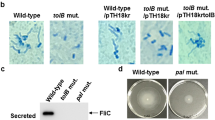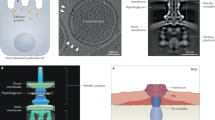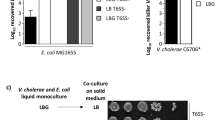Abstract
Enteric bacteria use a limited array of macromolecular systems to implement diverse pathogenic strategies. The cellular targets of several enteric virulence factors have recently been identified. The themes that have emerged from these studies include the exploitation of molecules that regulate the actin cytoskeleton and the activation of apoptotic pathways to serve the pathogen.
This is a preview of subscription content, access via your institution
Access options
Subscribe to this journal
Receive 51 print issues and online access
$199.00 per year
only $3.90 per issue
Buy this article
- Purchase on Springer Link
- Instant access to full article PDF
Prices may be subject to local taxes which are calculated during checkout





Similar content being viewed by others
References
Whittam, T.S. Escherichia coli and Salmonella: Cellular and Molecular Biology (ed. Neidhardt, F. C.) 2708–2720 (ASM Press, Washington, DC, 1996).
Lawrence, J. G. & Ochman, H. Molecular archaeology of the Escherichia coli genome. Proc. Natl Acad. Sci. USA 95, 9413–9417 (1998).
Waldor, M. K. & Mekalanos, J. J. Lysogenic conversion by a filamentous phage encoding cholera toxin. Science 272, 1910–1914 (1996).
Karaolis, D. K., Somara, S., Maneval, D. R. Jr Johnson, J. A. & Kaper, J. B. A bacteriophage encoding a pathogenicity island, a type-IV pilus and a phage receptor in cholera bacteria. Nature 399, 375–379 (1999).
Perna, N. T. et al. Molecular evolution of a pathogenicity island from enterohemorrhagic Escherichia coli O157:H7. Infect. Immun. 66, 3810–3817 (1998).
Thanassi, D. G., Saulino, E. T. & Hultgren, S.J. The chaperone/usher pathway: a major terminal branch of the general secretory pathway. Curr. Opin. Microbiol. 1, 223–231 (1998).
Yoshida, T., Kim, S. R. & Komano, T. Twelve pil genes are required for biogenesis of the R64 thin pilus. J. Bacteriol. 181, 2038–2043 (1999).
Anantha, R. P., Stone, K. D. & Donnenberg, M. S. S. Effects of bfp mutations on biogenesis of functional enteropathogenic Escherichia coli type IV pili. J. Bacteriol. 182, 2498–2506 (2000).
Hamburger, Z. A., Brown, M. S., Isberg, R. R. & Bjorkman, P. J. Crystal structure of invasin: a bacterial integrin-binding protein. Science 286, 291–295 (1999).
Luo, Y. et al. Crystal structure of enteropathogenic Escherichia coli intimin–receptor complex. Nature 405, 1073–1077 (2000).
Russel, M. Macromolecular assembly and secretion across the bacterial cell envelope: type II protein secretion systems. J. Mol. Biol. 279, 485–499 (1998).
Marciano, D. K., Russel, M. & Simon, S. M. An aqueous channel for filamentous phage export. Science 284, 1516–1519 (1999).
Young, G. M., Schmiel, D. H. & Miller, V. L. A new pathway for the secretion of virulence factors by bacteria: the flagellar export apparatus functions as a protein-secretion system. Proc. Natl Acad. Sci. USA 96, 6456–6461 (1999).
Kubori, T. et al. Supramolecular structure of the Salmonella typhimurium type III protein secretion system. Science 280, 602–605 (1998).
Blocker, A. et al. The tripartite type III secreton of Shigella flexneri inserts IpaB and IpaC into host membranes. J. Cell Biol. 147, 683–693 (1999).
Knutton, S. et al. A novel EspA-associated surface organelle of enteropathogenic Escherichia coli involved in protein translocation into epithelial cells. EMBO J. 17, 2166–2176 (1998).
Tardy, F. et al. Yersinia enterocolitica type III secretion-translocation system: channel formation by secreted Yops. EMBO J. 18, 6793–6799 (1999).
Davis, B. M. et al. Convergence of the secretory pathways for cholera toxin and the filamentous phage, CTXφ. Science 288, 333–335 (2000).
Donnenberg, M. S., Kaper, J. B. & Finlay, B. B. Interactions between enteropathogenic Escherichia coli and host epithelial cells. Trends Microbiol. 5, 109–114 (1997).
Knutton, S., Shaw, R. K., Anantha, R. P., Donnenberg, M. S. & Zorgani, A. A. The type IV bundle-forming pilus of enteropathogenic Escherichia coli undergoes dramatic alterations in structure associated with bacterial adherence, aggregation and dispersal. Mol. Microbiol. 33, 499–509 (1999).
Anantha, R. P., Stone, K. D. & Donnenberg, M. S. The role of BfpF, a member of the PilT family of putative nucleotide-binding proteins, in type IV pilus biogenesis and in interactions between enteropathogenic Escherichia coli and host cells. Infect. Immun. 66, 122–131 (1998).
Bieber, D. et al. Type IV pili, transient bacterial aggregates, and virulence of enteropathogenic Escherichia coli. Science 280, 2114–2118 (1998).
Kenny, B. et al. Enteropathogenic E. coli (EPEC) transfers its receptor for intimate adherence into mammalian cells. Cell 91, 511–520 (1997).
Sanger, J. M., Chang, R., Ashton, F., Kaper, J. B. & Sanger, J. W. Novel form of actin-based motility transports bacteria on the surface of infected cells. Cell Motil. Cytoskeleton 34, 279–287 (1996).
Sansonetti, P. J., Tran, V. N. & Egile, C. Rupture of the intestinal epithelial barrier and mucosal invasion by Shigella flexneri. Clin. Infect. Dis. 28, 466–475 (1999).
Ménard, R., Prévost, M. C., Gounon, P., Sansonetti, P. & Dehio, C. The secreted Ipa complex of Shigella flexneri promotes entry into mammalian cells. Proc. Natl Acad. Sci. USA 93, 1254–1258 (1996).
Cudmore, S., Cossart, P., Griffiths, G. & Way, M. Actin-based motility of vaccinia virus. Nature 378, 636–638 (1995).
Loisel, T. P., Boujemaa, R., Pantaloni, D. & Carlier, M. F. Reconstitution of actin-based motility of Listeria and Shigella using pure proteins. Nature 401, 613–616 (1999).
Jensen, V. B., Harty, J. T. & Jones, B. D. Interactions of the invasive pathogens Salmonella typhimurium, Listeria monocytogenes, and Shigella flexneri with M cells and murine Peyer's patches. Infect. Immun. 66, 3758–3766 (1998).
Sansonetti, P. J., Arondel, J., Cavaillon, J.-M & Huerre, M. Role of interleukin-1 in the pathogenesis of experimental shigellosis. J. Clin. Invest. 96, 884–892 (1995).
Achtman, M. et al. Yersinia pestis, the cause of plague, is a recently emerged clone of Yersinia pseudotuberculosis. Proc. Natl Acad. Sci. USA 96, 14043–14048 (1999).
Cornelis, G. R. & Wolf-Watz, H. The Yersinia Yop virulon: a bacterial system for subverting eukaryotic cells. Mol. Microbiol. 23, 861–867 (1997).
Monack, D. M., Mecsas, J., Bouley, D. & Falkow, S. Yersinia-induced apoptosis in vivo aids in the establishment of a systemic infection of mice. J. Exp. Med. 188, 2127–2137 (1998).
Mirold, S. et al. Isolation of a temperate bacteriophage encoding the type III effector protein SopE from an epidemic Salmonella typhimurium strain. Proc. Natl Acad. Sci. USA 96, 9845–9850 (1999).
Fu, Y. X. & Galán, J. E. A Salmonella protein antagonizes Rac-1 and Cdc42 to mediate host-cell recovery after bacterial invasion. Nature 401, 293–297 (1999).
Hersh, D. et al. The Salmonella invasin SipB induces macrophage apoptosis by binding to caspase-1. Proc. Natl Acad. Sci. USA 96, 2396–2401 (1999).
Hensel, M. et al. Simultaneous identification of bacterial virulence genes by negative selection. Science 269, 400–403 (1995).
Vazquez-Torres, A. et al. Salmonella pathogenicity island 2-dependent evasion of the phagocyte NADPH oxidase. Science 287, 1655–1658 (2000).
Uchiya, K. et al. A Salmonella virulence protein that inhibits cellular trafficking. EMBO J. 18, 3924–3933 (1999).
Kalman, D. et al. Enteropathogenic E. coli acts through WASP and Arp2/3 complex to form actin pedestals. Nature Cell Biol. 1, 389–391 (1999).
Ben-Ami, G. et al. Agents that inhibit Rho, Rac, and Cdc42 do not block formation of actin pedestals in HeLa cells infected with enteropathogenic Escherichia coli. Infect. Immun. 66, 1755–1758 (1998).
Egile, C. et al. Activation of the CDC42 effector N-WASP by the Shigella flexneri IcsA protein promotes actin nucleation by Arp2/3 complex and bacterial actin-based motility. J. Cell Biol. 146, 1319–1332 (1999).
Van Nhieu, G. T., Caron, E., Hall, A. & Sansonetti, P. J. IpaC induces actin polymerization and filopodia formation during Shigella entry into epithelial cells. EMBO J. 18, 3249–3262 (1999).
Tran Van Nhieu, G., Ben-Ze'ev, A. & Sansonetti, P. J. Modulation of bacterial entry into epithelial cells by association between vinculin and the Shigella IpaA invasin. EMBO J. 16, 2717–2729 (1997).
Bourdet-Sicard, R. et al. Binding of the Shigella protein IpaA to vinculin induces F-actin depolymerization. EMBO J. 18, 5853–5862 (1999).
Zhou, D. G., Mooseker, M. S. & Galán, J. E. An invasion-associated Salmonella protein modulates the actin-bundling activity of plastin. Proc. Natl Acad. Sci. USA 96, 10176–10181 (1999).
Hayward, R. D. & Koronakis, V. Direct nucleation and bundling of actin by the SipC protein of invasive Salmonella. EMBO J. 18, 4926–4934 (1999).
Hardt, W. D., Chen, L. M., Schuebel, K. E., Bustelo, X. R. & Galán, J. E. S. typhimurium encodes an activator of Rho GTPases that induces membrane ruffling and nuclear responses in host cells. Cell 93, 815–826 (1998).
Palmer, L. E., Hobbie, S., Galán, J. E. & Bliska, J. B. YopJ of Yersinia pseudotuberculosis is required for the inhibition of macrophage TNF-α production and downregulation of the MAP kinases p38 and JNK. Mol. Microbiol. 27, 953–965 (1998).
Schesser, K. et al. The yopJ locus is required for Yersinia-mediated inhibition of NF-κB activation and cytokine expression: YopJ contains a eukaryotic SH2-like domain that is essential for its repressive activity. Mol. Microbiol. 28, 1067–1079 (1998).
Persson, C. et al. Localization of the Yersinia PTPase to focal complexes is an important virulence mechanism. Mol. Microbiol. 33, 828–838 (1999).
Black, D. S. & Bliska, J. B. Identification of p130Cas as a substrate of Yersinia YopH (Yop51), a bacterial protein tyrosine phosphatase that translocates into mammalian cells and targets focal adhesions. EMBO J. 16, 2730–2744 (1997).
Persson, C., Carballeira, N., Wolf-Watz, H. & Fällman, M. The PTPase YopH inhibits uptake of Yersinia, tyrosine phosphorylation of p130Cas and FAK, and the associated accumulation of these proteins in peripheral focal adhesions. EMBO J. 16, 2307–2318 (1997).
Zumbihl, R. et al. The cytotoxin YopT of Yersinia enterocolitica induces modification and cellular redistribution of the small GTP-binding protein RhoA. J. Biol. Chem. 274, 29289–29293 (1999).
Acknowledgements
I thank J. B. Kaper for critically reviewing the manuscript. The author's work is supported by Public Health Service awards from the National Institutes of Health.
Author information
Authors and Affiliations
Rights and permissions
About this article
Cite this article
Donnenberg, M. Pathogenic strategies of enteric bacteria. Nature 406, 768–774 (2000). https://doi.org/10.1038/35021212
Published:
Issue Date:
DOI: https://doi.org/10.1038/35021212
This article is cited by
-
Imperatorin inhibits the expression of alpha-hemolysin in Staphylococcus aureus strain BAA-1717 (USA300)
Antonie van Leeuwenhoek (2016)
-
Diosmetin inhibits the expression of alpha-hemolysin in Staphylococcus aureus
Antonie van Leeuwenhoek (2015)
-
Moraxella osloensis Gene Expression in the Slug Host Deroceras reticulatum
BMC Microbiology (2008)
-
Biological and biomedical implications of the co-evolution of pathogens and their hosts
Nature Genetics (2002)
-
Microbial killing: hold the bleach and pass the salt!
Nature Immunology (2002)
Comments
By submitting a comment you agree to abide by our Terms and Community Guidelines. If you find something abusive or that does not comply with our terms or guidelines please flag it as inappropriate.



